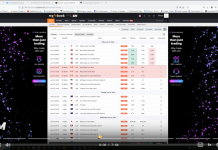 The United States is leading the way in the extraction of many mineral resources. For more than a decade, it has been on the podium of countries extracting crude oil and natural gas, mainly due to the so-called shale revolution. But the United States is not just oil and gas.
The United States is leading the way in the extraction of many mineral resources. For more than a decade, it has been on the podium of countries extracting crude oil and natural gas, mainly due to the so-called shale revolution. But the United States is not just oil and gas.
In the United States there are large reserves of coal, iron ore, copper, zinc but also precious metals such as gold. Gold has for centuries aroused the great excitement of ordinary seekers, investors and many others. Let’s take a closer look at the history of gold mining and exploration in the United States.
A brief history of gold fever in the USA
Gold was a sought precious metal even before Christ. Gold rush began in the United States in the 19th century. In 1848, when California was a territory belonging to Mexico, but the US-occupied one of the cowboys found a golden nugget. The news spread quickly and nearby residents began to search for this precious metal. A year later the gold rush swept across the East Coast, which headed west for precious metal. Most of the area did not belong to anyone, because the property rights of Native Americans were not accepted. A rather unusual custom was developed, which allowed us to search for gold on every free plot, and leaving it meant that the search was abandoned.
Colorado has become another place where gold seekers went, exactly a decade later. Initially, no one wanted to explore inaccessible mountain areas, expecting much easier crops in California. Over time, however, some people decided to move to Colorado because of the easily accessible deposits in California was ended up.
Gold rush even reached Alaska. This area is the least populated region of the United States, and was purchased by Washington from Russia in 1867. The main transportation route in Alaska was the 1980 mile (3,200 km) Yukon river and its mouth in the Bering Sea. Yukon also flows through Canada and is the largest river in North America. Alaska’s exploration for gold was not the easiest, but it did not deter the amateurs of the precious metal. A real gold rush erupted in Alaska at the end of the 19th century in some hot summer, when the river level fell heavily, and the precipitation was very low.
Currently, gold is mined most often in deep and open mines controlled by multinational corporations whose shares are quoted on stock exchanges in London and New York. Let’s look at the behavior of gold prices and the share price of the companies involved in gold extraction.
Gold vs. stock of gold mining companies
Gold prices usually move in the opposite direction to the dollar, US bond yields outstrip the behavior of the CRB index, and also give preliminary signals about the future direction of inflation. In addition, during periods of political and financial uncertainty, gold is considered the safest investment. More precisely, gold is perceived as the best investment at the time of negative real interest rates, it means when inflation is higher than interest rates. Investment in bonds give less profit than inflation.
Gold and prices of mining companies usually go in the same direction. This correlation is very strong and is nowhere near as good as in this case. When divergences emerge, this is a warning against a change in trend. Contrary to appearances, the stocks of mining companies usually precede price movements of gold.
In addition, the prices of mining companies are growing much stronger than gold and vice versa. This is connected with a stronger earnings growth of mining companies than the prices of gold. When the price of gold fluctuates around $ 1200 per ounce and the cost of extraction is about $ 1,000 per ounce, the company’s gross profit is $ 200 per ounce. The increase in gold prices to $ 1300 per ounce means the prices increase by about 8%. In turn, the profitability of the mining company will increase from $ 200 to $ 300 per ounce, which is 50%. For this simple reason, the prices of mining companies usually go higher than the price of gold. Unfortunately, this is happening in both directions, and also the fall in gold prices means much stronger declines in the prices of companies dealing with gold extraction.
We will now look at the largest mining companies listed on the New York Stock Exchange and more.
BHP Billiton
Currently the world’s largest mining company. The company name and structure is the result of a merger of the Australian company Broken Hill Proprietary Company with British Billiton. The company deals with extracting almost anything that can be found in the ground. It extracts iron, diamonds, gold, silver, copper, coal, oil, etc. The company is headquartered in Melbourne, Australia. The company is listed on the Australian, New York and London stock exchanges.
Some relevant market data (as of March 2017)
- CEO – Andrew Mackenzie
- Number of employees – 65 263
- Headquarters – Melbourne, Australia
- Shares Outstanding – 1,60 billion
- Float Current – 1,60 billion
- Held by Insiders – 0%
- Held by Institutions – 3,11%
- Market Cap – 54,30 billion USD
- Price/Earnings – 36,46
- Price/Earnings for the whole industry – 35,90
- P/E CAPE Shiller – 10,01
- Over the past 13 years, P/E CAPE Shillera ratio was the highest at 60,68; the lowest at 5,75; and the median at 17,26
- P/E CAPE Shiller for the whole industry – 28,00
- Revenue for the last year – 33,98 billion USD
- Increase/decrease revenue for the last year – 12,43%
- EBITDA for the last year – 15,28 billion USD
- Net Income for the last year – 2,46 billion USD
- Earnings Per Share for the last year – 0,92 USD
- Increase/decrease earnings for the last year – (-142,28%)
- Dividend for the last year – 1,6 USD
- Dividend Yield – 4,73%
- 4 Year Average Yield – 3,94%
RioTinto
Rio Tinto, next to BHP Billiton, is the world’s second largest mining company. The company is headquartered in London and Melbourne, Australia. It is currently a British-Australian company but was founded in Spain in the region of Andalusia. The name comes from the Spanish river Rio Tinto. In 1873 Scottish industrialist Hugh Matheson assembled a group of financiers to purchase the Rio Tinto mine from the Spanish government. Under Matheson’s rule, Rio Tinto has become the largest copper producer in the world. It is currently extracting coal, iron, copper, gold, diamonds and many other raw materials. The company is listed on the Australian, New York and London stock exchanges.
Some relevant market data (as of March 2017)
- CEO – Jean-Sébastien Jacques
- Number of employees – 51 018
- Headquarters – London, England
- Shares Outstanding – 1,37 billion
- Float Current – 1,38 billion
- Held by Insiders – 0%
- Held by Institutions – 6,88%
- Market Cap – 52,63 billion USD
- Price/Earnings – 15,67
- Price/Earnings for the whole industry – 35,90
- P/E CAPE Shiller – 17,46
- Over the past 13 years, P/E CAPE Shillera ratio was the highest at 50,95; the lowest at 6,99; and the median at 17,76
- P/E CAPE Shiller for the whole industry – 28,00
- Revenue for the last year – 31,99 billion USD
- Increase/decrease revenue for the last year – (-6,48%)
- EBITDA for the last year – 10,70 billion USD
- Net Income for the last year – 4,36 billion USD
- Earnings Per Share for the last year – 2,42 USD
- Increase/decrease earnings for the last year – (-583.63 %)
- Dividend for the last year – 2,51 USD
- Dividend Yield – 6,6%
- 4 Year Average Yield – 4,92%
Newmont Mining Corporation
 Newmont Mining Corporation is an American company based in Greenwood Village, Colorado. It was founded by American engineer and financier William Boyce Thompson in 1921. It mainly deals with metal extraction. It is currently the largest gold producer producing about 5 million ounces a year. Other metals being mined are silver and copper. Although the company has its roots in the United States, it operates around the world. It owns mines in Mexico, Peru, Australia, New Zealand, Ghana. The company is listed on the New York Stock Exchange and is part of the S&P 500 index. It is one of the largest mining companies in the world.
Newmont Mining Corporation is an American company based in Greenwood Village, Colorado. It was founded by American engineer and financier William Boyce Thompson in 1921. It mainly deals with metal extraction. It is currently the largest gold producer producing about 5 million ounces a year. Other metals being mined are silver and copper. Although the company has its roots in the United States, it operates around the world. It owns mines in Mexico, Peru, Australia, New Zealand, Ghana. The company is listed on the New York Stock Exchange and is part of the S&P 500 index. It is one of the largest mining companies in the world.
Some relevant market data (as of March 2017)
- CEO – Gary J. Goldberg
- Number of employees – 23 200
- Headquarters – Greenwood Village, Colorado
- Shares Outstanding – 533,23 million
- Float Current – 531,36 million
- Held by Insiders – 0,34%
- Held by Institutions – 85,84%
- Market Cap – 17,21 billion USD
- Price/Earnings – N/A
- Price/Earnings for the whole industry – 35,90
- P/E CAPE Shiller – 68,68
- Over the past 13 years, P/E CAPE Shillera ratio was the highest at 1374; the lowest at 18,26; and the median at 47,29
- P/E CAPE Shiller for the whole industry – 28,00
- Revenue for the last year – 7,27 billion USD
- Increase/decrease revenue for the last year – (-6,57%)
- EBITDA for the last year – 2,68 billion USD
- Net Income for the last year – (-33) million USD
- Earnings Per Share for the last year – (-0,06)USD
- Increase/decrease earnings for the last year – (-140.71 %)
- Dividend for the last year – 0,2 USD
- Dividend Yield – 0,62%
- 4 Year Average Yield – 1,86%

















